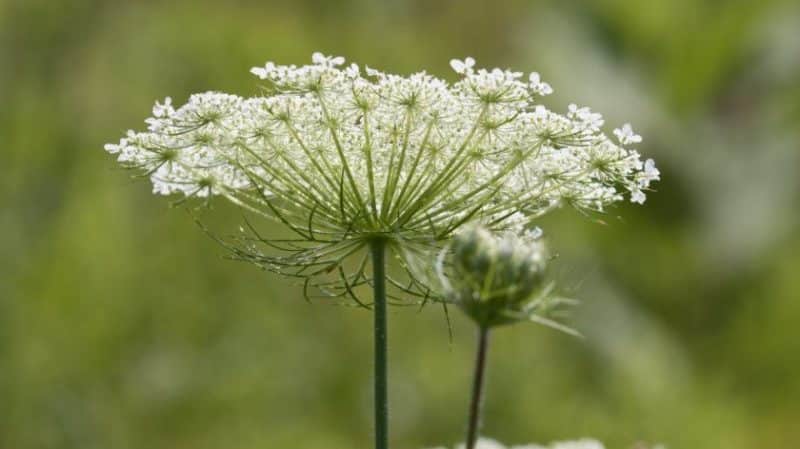What type of inflorescence does a carrot have: description and characteristics
Sowing carrots are a biennial herbaceous plant of the Apiaceae family with a fruit shoot height of 60-70 cm. Popularly called “carrot” they mean a juicy orange root with an elongated cylindrical shape. The root crop of the plant is eaten, and reproduction occurs through the inflorescence. We will tell you in detail what kind of inflorescence a carrot has.
What is an inflorescence
This is the part of the plant's vegetative system that produces flowers and subsequently bears seeds. Inflorescences are formed inside flower or mixed buds, and are located at the top of the annual shoot and are more or less clearly limited from it.
Inflorescences are produced exclusively by angiosperms in the upper part of the stem. During evolution, such a structure appeared for the purpose of unhindered pollination by insects or wind.
Botanical description and characteristics of carrots
Carrot is a biennial plant. Classification: kingdom Plants, department Flowering, class Dicotyledonous, order Umbelliferae, family Umbelliferae, genus Daucus (Carrot).
In the year of planting, the plant forms a fleshy root crop and a rosette of basal, pinnate, highly dissected leaves. The general outline of the leaves: broadly lanceolate, with long stalks and intense green color.
On a note! Initially, the crop was grown for its aromatic seeds and leaves.
In the diversity of the genus, two varieties are distinguished:
- wild carrots, or common carrot (Daucus carota). It grows in nature, but is not suitable for food. Habitat: Eurasia, Africa, Australia.
- Sowing carrots (Daucuscarota sativus). Subspecies wild. It is cultivated by humans on all continents, in regions with mild and temperate climates.
There are two types of cultivated carrots:
- Stern. It is cultivated to obtain feed raw materials for cattle, poultry and small domestic animals. The root crop has a cylindrical or elongated conical shape and is not used for the human diet. The length of the root crop reaches 40-50 cm, the color is from light to dark orange.
- Dining room. Varieties with different ripening periods (early ripening, mid-ripening, late ripening) and a growing season of 90-100 days. Table carrot roots of any variety are consumed raw or after heat treatment. The harvest is suitable for long-term storage in winter.
Chemical composition of the vegetable unique and varied. The ripened root vegetable contains carotene, vitamins group B, lycopene, ascorbic and pantothenic acid, sugars and other micro- and macroelements vital for humans.
Depending on the variety, table carrots are white, yellow, orange, red and even purple. The ratio of coloring pigments (carotenoids and anthocyanins) affects the color of root vegetables. The shape of the root crop is from round to elongated cylindrical or cone-shaped, with a sharp or rounded tip. The vegetable is one of the ten strategically important food crops in the world.
Interesting! Carrot tops contain 6-7 times more vitamin C than root vegetables.
Carrots are bred by sowing seeds in the ground in early spring or late autumn under snow. The highest yields are obtained from light loamy and sandy loam soils, subject to deep plowing of the arable horizon. Seeds germinate at soil temperatures of 0…+3°C.
The first shoots easily tolerate frosts down to -3...-4°C, so the crop is classified as cold-resistant. The optimal temperature regime for intensive growth and development of root crops is +22…+25°C.
Type of inflorescence in carrots
Carrots, like parsley, have an inflorescence of a complex umbrella, consisting of several simple umbrellas. The crop blooms in the second year of growth, after which it produces seeds.
Description and characteristics
The plant throws out a strong, erect, ribbed stem in the second year. The stem height of the table crop is 60-7 cm, and that of the wild crop is up to 1.2 m.
Carrots are classified as insect-pollinated plants. The flowering period is extended - up to 45 days. The fruits are small elliptical two-seeded seeds up to 5 mm long with two rows of spines.
Appearance
The inflorescence is a complex umbrella of 10-15 rough-pubescent rays, spread out during flowering. The flowers are bisexual, collected in round umbels.
Flower type: green calyx, inconspicuous teeth, five light petals, five stamens, pistil with lower ovary.

Classification of inflorescence
The flowers in the complex umbellate inflorescence of carrots sit on second-order axes, the distances between the axes are shortened. The second order axes move away from the first order axis. The distance between the pedicels is shortened; they extend from the tips of the second-order axes. The second-order axes are equal in height. The set of bracts at the axes of the second order constitutes a general involucre, and at the base of the pedicels - a private one. Flowers bloom from the periphery to the center. Each subsequent order blooms after the previous one has faded.
Read also:
Features of red carrots without core.
The standard French variety of carrots is Carotel.
How to determine when to remove carrots from the garden for storage.
Conclusion
The carrot inflorescence belongs to complex, monopodial umbels with clearly defined general and private involucres. Seeds dropped on their own produce bitter, unedible roots the following year. This means that table carrots require constant selection in compliance with the rules of agricultural technology to preserve varietal characteristics.